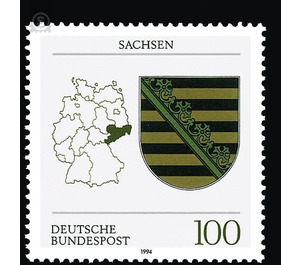Coat of arms of the Land of the Federal Republic of Germany (3) - Germany / Federal Republic of Germany 1994 - 100 Pfennig
Theme: Art & Culture
| Country | Germany / Federal Republic of Germany |
| Issue Date | 1994 |
| Face Value | 100.00 |
| Color | multi-colored white |
| Perforation | K 13 3/4 |
| Printing Type | Multicolor offset printing |
| Stamp Type | Postage stamp |
| Item Type | Stamp |
| Chronological Issue Number | 1586 |
| Chronological Chapter | GER-BRD |
| SID | 465462 |
| In 42 Wishlists | |
Since the resurrection of Saxony with a ceremony on the Albrechtsburg to Meissen on October 3, 1990, the coat of arms with the nine times divided by black and gold shield, which covers an obliquely green diamond crown, has again become the symbol of the Free State and its citizens. On October 25, 1991, the Saxon Landtag adopted the "Law on the Coat of Arms of the Free State of Saxony," which was issued on November 18, 1991 and proclaimed four days later. Thus, the constitution of the state had been reorganized under the conscious preservation of centuries of traditions. This Saxon coat of arms, which also leads the state of Saxony-Anhalt as a partial coat of arms, goes back to the established in the High Middle Ages duchy of Saxony with Wittenberg and Lauenburg, which was rebuilt after the destruction of the duchy of Saxony under Henry the Lion of Emperor Frederick Barbarossa. He transferred it in 1180 to the Ascanian Bernhard III, a son of Albrecht the Bear, the founder of the Duchy of Brandenburg. At the end of the twelfth century, the Ascanian dukes, beginning with Bernhard's son Albrecht I, led the shield, which was divided into black and gold, as their hallmark. Around 1260, the dukes of Saxe-Wittenberg took the green diamond wreath as an example in their coat of arms on to mark the abandonment of the askanischen native land of Lower Saxony with Lauenburg. When the Ascanian family of the dukes of Saxe-Wittenberg went out in 1422, the German king Sigismund invaded the duchy as a completed imperial fief. Military services rendered to the king against the Hussite movement in Bohemia were now entrusted to the Margrave of Meissen, Friedrich IV, with the Duchy of Saxony-Wittenberg. With that the Wettiner rose into the circle of the highest-ranking imperial princes. This was at the same time the foundation of the Wettin Electorate, in which the Margraviate of Meissen and the Landgraviate of Thuringia were absorbed. With this significant increase in rank then transferred in the following decades, the name of Saxony from the Duchy of Saxe-Wittenberg on the Margraviate of Meissen, the Easter and the Pleißenland, in the end on the entire Wettin territorial possession, the Wettiner since their appointment as Margrave of Meissen in the Years 1089 had brought together. For this new Electorate of Saxony, the coat of arms of the Duchy of Saxony-Wittenberg became the highest ranking state symbol. After the division of Leipzig in 1485 this coat of arms led the Ernestine elector as well as the Albertine dukes. When the Albertine Duke Moritz of Saxony after the Wittenberg surrender of 1547 by Emperor Charles V with the electorate and most of the former Ernestine Electorate, including the Duchy of Saxe-Wittenberg, was lent, also for the new Albertine Electorate of Saxony, the coat of arms of the former Ascanian Duchy the most important symbol of the state. This Saxon diamond coat of arms chose Elector Friedrich August III. to the state emblem, as 1806 from the electorate became the Kingdom of Saxony. It remained even after the Pressburg peace of 1815 with the reduction of Saxony by two-thirds of its territory. After the November Revolution of 1918 and the abdication of King Friedrich August III. The Free State of Saxony took over this coat of arms as the valid state coat of arms. This remained until the elimination of Saxony in the summer of 1952. (Text: Dr. Reiner Groß, Dresden)


